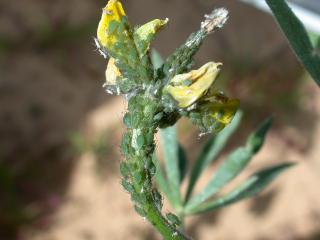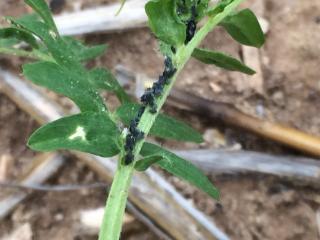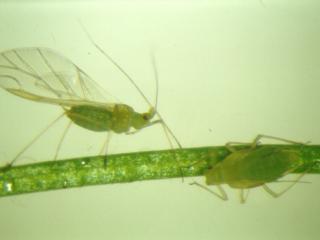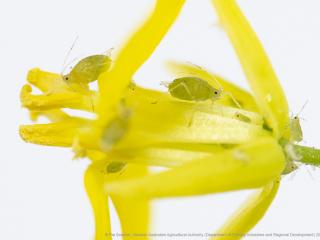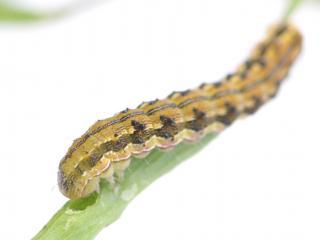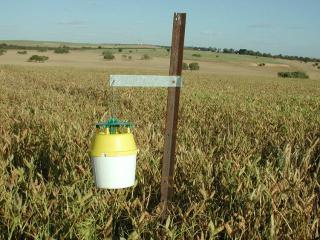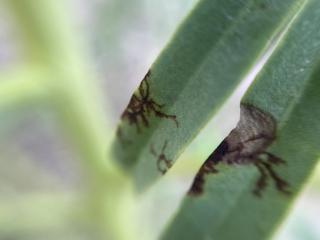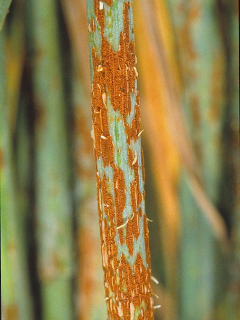Identifying aphids in legume crops
- Geraldton
- Mingenew
- Salmon Gums
Farmers near Mingenew and Geraldton report finding low levels of blue green aphids in flowering lupin crops, with less than 1% of the plants currently affected.
Plant pathologist Andrea Hills (DPIRD) has reported seeing cowpea aphids on vetch north of Salmon Gums.
Cowpea aphids, bluegreen aphids and green peach aphid are the most common species that attack legume crops.
Cowpea aphids are usually easily spotted by their black colour and dense clusters on a few plant growing points. On close inspection with a magnifying lens their black and white legs are also a good identification feature.
The bluegreen aphid (BGA) can measure up to 3mm long. They are oval shaped, with long legs and antennae. They have two large cornicles that extend beyond the base of the abdomen. Both the winged and wingless forms are a matte bluish-green colour. Nymphs are similar to adults but are smaller in size. This species prefers to feed on legumes and is a common pest of medic and sub-clover pastures. Large numbers of winged BGA fly from pastures to lupin crops later in the growing season. This species builds up to heavy colonies throughout the crop on susceptible lupin varieties.
The green peach aphid (GPA) tends to be shiny or waxy and ranges from yellow, through to green and pink in colour. The yellowy-green GPAs are similar in colour to young unfurled lupin leaves. The winged GPAs have a dark patch on their backs.
Aphids can damage lupin crops through both feeding damage and virus transmission (cucumber mosaic virus and bean yellow mosaic virus). The degree of feeding damage depends on the varietal susceptibility, the growth stage of the crop, the percentage of plants infested and the duration of the infestation.
The spray threshold for control of aphids on lupins is for more than 30% of flowering spikes to have 30 or more aphids. Consideration should also be given to potential crop yield.
Mild winter conditions leading into the warmer spring weather encourages aphid development and spread, setting up populations for severe crop damage if left unchecked.
Beneficial insects such as parasitoid wasps, ladybird beetles, hoverflies and lacewings, can be effective at reducing aphid numbers during spring. For more information refer to DPIRD’s Know what beneficials look like in your crop page.
For a list of insecticides registered for use on aphids see DPIRD’s 2021 Winter/Spring Insecticide Guide.
For more information on these aphids refer to DPIRD’s Identification of aphids in lupin crops and Management of aphids in Western Australian lupin crops pages.
For more information contact Research scientist Svetlana Micic, Albany on +61 (0)8 9892 8591 or Technical officer Alan Lord, South Perth on +61 (0)8 9368 3758.
Article authors: Cindy Webster (DPIRD Narrogin) and Alan Lord (DPIRD South Perth).
Check susceptible crops for native budworm
Caterpillar activity
- Chapman Valley
- Southern Cross
A farmer has reported finding three native budworm caterpillars per 10 sweeps in a flowering lupin crop near the Chapman Valley this week.
A budworm trapper captured four native budworm caterpillars per 10 sweeps in a flowering chickpea crop near Southern Cross. Southern Cross has also reported some of the higher numbers of moths caught in traps over recent weeks indicating more caterpillars are likely to appear in coming weeks.
Native budworm moth trapping surveillance
- Usual automated and manual trapping locations
Recent native budworm moth trap numbers have been much lower in comparison to early August 2020 and early August 2019. The high number of cold fronts passing across the state are suspected to have suppressed the westward migration of moths during July. Although some higher numbers are now beginning to appear in the eastern (Southern Cross) and northern (Merkanooka) grainbelt.
Native budworm populations can also be reduced when eggs and very small larvae are dislodged from plants during heavy rain and wind.
The higher budworm moth numbers reported this week by volunteer farmers, agronomists, DPIRD staff and automated traps include: Merkanooka (63 moths), Southern Cross (34), Canna (12), Badgingarra (12) and Kirwan (10).
Results of this week's manual trappings are available at the department’s Native budworm moth numbers 2021.
A mapped view of the native budworm trap captures is available at Cesar Australia’s MothTrapVisWA page. Viewers need to select the desired trapping date range.
Sweep net susceptible crops
Field pea, faba bean, lentil and chickpea crops are very susceptible to native budworm as their pods are attractive to all sizes of caterpillars. These crops need to be checked regularly after the commencement of flowering. The trap numbers only provide an indication of the pest’s activity and cannot be relied upon for control decisions. Only the use of a sweep net to regularly check crops for the caterpillars can give growers confidence in the levels of budworm present.
Pesticide options for the control of native budworm can be found in DPIRD’s 2021 winter spring insecticide guide.
Detailed information on this pest can be found at the department’s Management and economic thresholds for native budworm.
For more information contact Technical Officer Alan Lord, South Perth +61 (0)8 9368 3758 or +61 (0)409 689 468.
Article author: Alan Lord (DPIRD South Perth).
Brown spot in lupins
- Mingenew
Technical officer Amber Balfour-Cunningham (DPIRD) has recently found brown spot in early flowering lupins near Mingenew.
Low levels of brown spot can often be seen in areas with regular lupin cropping, particularly in wetter winters such as this season but seldom cause significant crop damage under current production systems.
Brown spot (Pleiochaeta setosa) spores are present in soils where lupins have been grown previously. Lupin leaves infected with brown spot drop to the ground and spores are produced on the dead tissue. These spores become incorporated into the surface layers of the soil and remain dormant there. Spores can persist in the soil for several years through non-lupin rotations, although their population reduces over time.
Spores are splashed by rain from the soil surface onto leaves of lupin plants resulting in the appearance of dark brown lesions which can distort leaves and result in premature defoliation. Oldest leaves are affected first. Newly emerged seedlings and young plants are at greatest risk of brown spot infection. High levels of brown spot infection can significantly retard early growth of lupin crops and in the most severe cases can cause seedling death.
The same fungus causes both brown leaf spot and Pleiochaeta root rot in lupins.
Plant pathologist Geoff Thomas says that recent frequent and heavy rain have provided a perfect opportunity for splash of soil and Pleiochaeta spores within lupin canopies.
The impact of brown spot can be reduced through rotation of crops, the use of seed dressings and through measures which reduce spore splash such as retention of cereal stubble. Foliar sprays are ineffective and not registered for this disease.
As lupin rotations have widened and with greater levels of cereal stubble retention reducing soil splash, severe brown spot is less common, although lupin crops will often have low levels of disease symptoms on lower older leaves.
For more information refer to the department’s Diagnosing brown spot in narrow-leafed lupins page.
For more information contact Plant Pathologist Geoff Thomas, South Perth on +61 (0)8 9368 3262.
Article author: Geoff Thomas (DPIRD South Perth).
Stem rust in volunteer oats
- Quairading
- Williams
- Newdegate
Nathan Moyes (Imtrade) reports that stem rust is present in self-sown oats in Quairading, Williams and Newdegate.
Plant pathologist Kylie Chambers (DPIRD) says that stem rust of oats attacks only oats and wild oats and will not infect barley or wheat. It can cause major yield loss in susceptible oat varieties grown for grain or hay production. Spores are windborne and can spread over large distances through the air. Spores produced on self-sown oats and wild oats will act as a source of infection for crops as the season progresses.
Similar to wheat, oat stem rust is favoured by moist warm (18-30°C) weather, and as temperatures begin to increase as the season progresses into spring susceptible oat crops should be monitored for stem rust infection.
Oats can also be impacted by crown (leaf) rust, which has also been reported on self-sown and wild oats this season, monitoring is vital for best management of both rust species in susceptible varieties. For more information refer to the 2021 PestFax Issue 10 article Bacterial blight, Septoria avenae blotch and leaf rust are appearing in oats.
For a list of registered fungicides to use as foliar sprays visit DPIRD’s Registered foliar fungicides for cereals in Western Australia page.
Samples of all rusts can be sent for pathotype testing. Infected leaf samples should be mailed in paper envelopes (do not use plastic wrapping or plastic lined packages) along with your details and collection information (location, variety etc.) directly to The University of Sydney, Australian Rust Survey, Reply Paid 88076, Narellan NSW 2567. Free reply paid envelopes can be ordered from University of Sydney.
For further details see the University of Sydney's Australian Cereal Rust Survey page.
For further information including description of symptoms visit the department’s Diagnosing stem rust in oats or Oats: leaf diseases pages.
For more information contact Plant Pathologists Kylie Chambers, Northam on +61 (0)8 9690 2151, Geoff Thomas, South Perth on +61 (0)8 9368 3982 or Kithsiri Jayasena, Albany on +61 (0)8 9892 8477.
Article authors: Kylie Chambers (DPIRD Northam) and Geoff Thomas (DPIRD South Perth).

